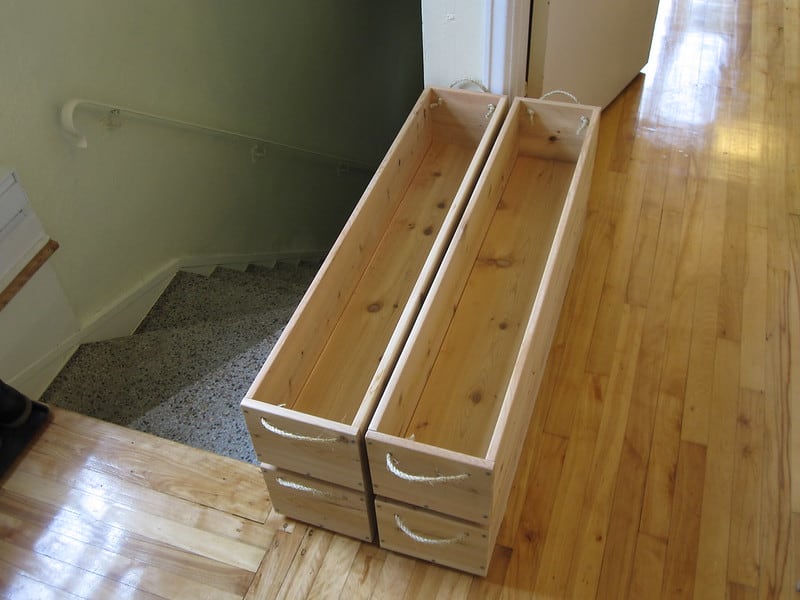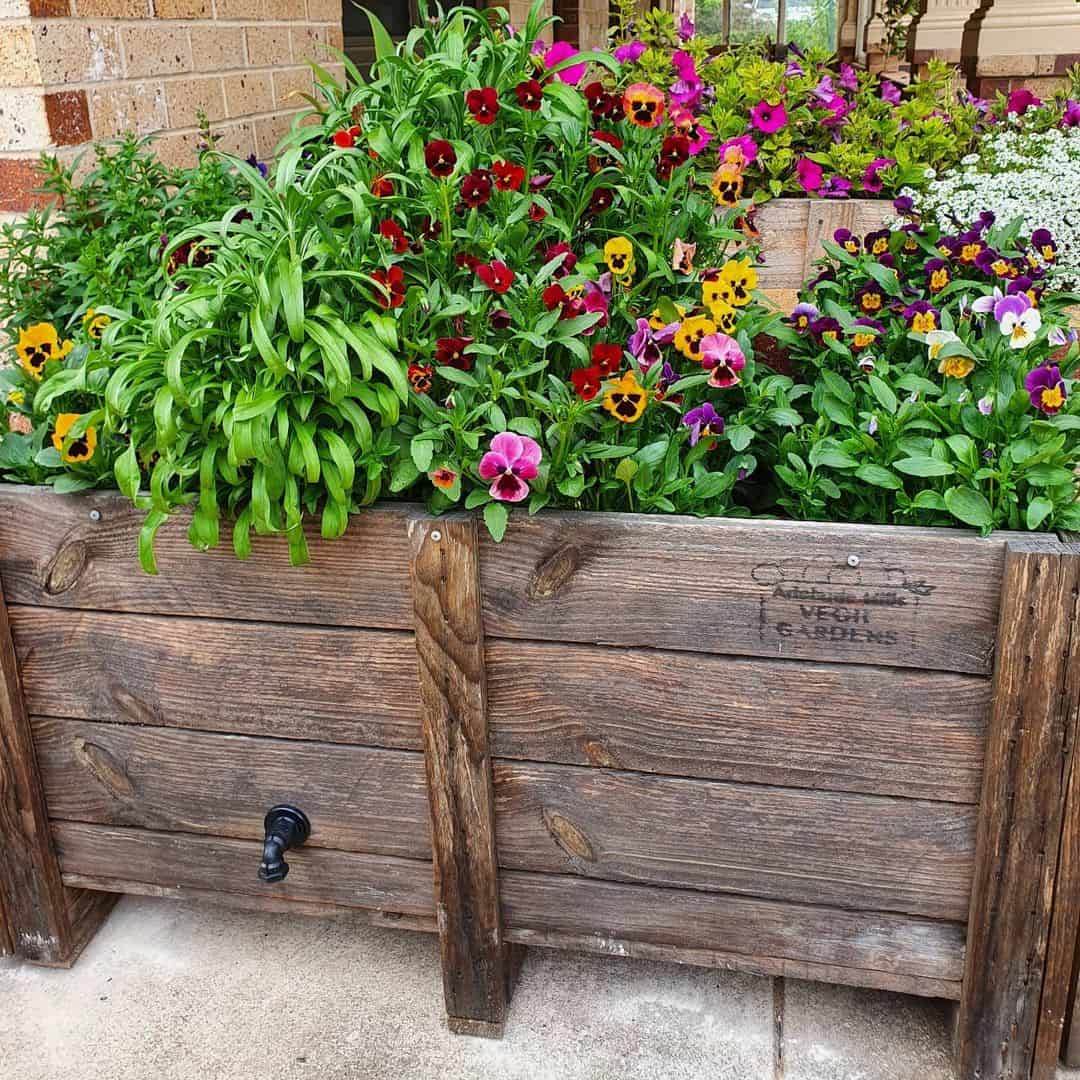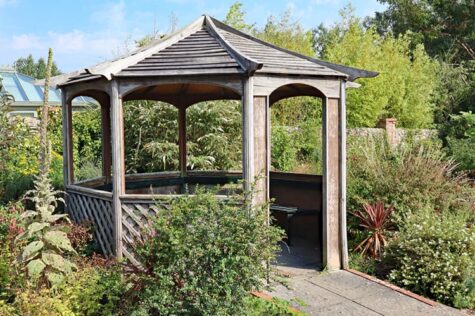Do you have a creative side? Then this project is for you. Flower boxes are a great way to bring some colour into your life and building your own can be extremely fun. Let’s take a look at how to make a wooden window flower box to hang outside your home.

Add some colour with a homemade flower box. Credit: Shutterstock
Supplies and tools
Before you begin your project, make sure you have a plan in mind. There are many different flower box designs out there, some easy and some more challenging.
For this project, we’ll be working with a simple flower box design that beginners will be able to take on. The end result will resemble the picture above. Here’s what you need to get started:
Tools
- Hammer
- Drill and drill bits
- Hand or circular saw
- Measuring tape
- Pencil
- Sander and sandpaper
- Paintbrush
- Spirit level
- L-square ruler
Supplies
- Screw plugs
- Screws
- Nails
- Wooden planks
- Wood preservative, stain or sealant
- Plastic lining
- L-brackets
- Wood glue
Method
Now that you have all the tools and supplies required to complete this task, let’s take a look at how to put together this flower box.
Step 1: Take some measurements
Most windows are designed to be a standard width of 488 mm, 630 mm, 915 mm, 1,200 mm or 1,770 mm. The easiest way to figure out how long your flower box needs to be is to measure the width of the window. For an outdoor, wall-hung flower box, you can make the long sides of your flower box just a bit longer than the width of the window.
Measure the window by placing one end of your measuring tape on the corner of the window where the walls meet. Extend the measuring tape all the way to the other corner to find the width of your window.
Add between 10 to 20 cm to your flowerbox measurements to make sure the box covers the window and just a little more on the side. To get the measurements of your flowerbox, make sure the edge of the plank you’ll be measuring is square. Use the L-square ruler to check this by placing one edge of the ruler on the length of the plank and line up the other with the edge you want to measure. If it lines up perfectly, your plank is cut square, if not, draw a line to correct it later.
Measure from your corrected edge to 10 or 20 cm longer than your window’s width. This means that if your window is 630 mm wide, your flower box sides will need to be 830 mm. Make sure to mark the cut-off and make a straight line with the L-square. This line will serve as a guide when the time comes to cut out your flower box sides.
Keep in mind that you will need 3 long planks and two short planks for your flower box. To find the measurements of the short sides, measure the width and depth of the planks. To get your height, take the width of the side planks minus the depth of these planks. For instance, if the width is 15 cm and the depth is 2.5 cm, you will need to measure 12.5 cm for both sides.
Doing this will allow the short sides to sit level with the long side planks while fitting on top of the bottom plank.
Step 2: Cut the planks
Now that all your measurements are done, you can start the cutting process. For this, you will need either a handsaw or a circular saw.
Find your pencil marks to know where to make your cuts. Hold down the planks and start sawing along the line. Once done you should have 3 long planks and two short ones. Don’t forget to correct any edges that aren’t square.
Step 3: Construct the flower box
For this step, you will need your wood glue, screws, a drill and drill bits. Start by securing one side to the bottom. Simply place the chosen bottom plank flat on your workbench or clamp it if you have a vice. Place the second plank at a 90-degree angle to the first. Use a drill to create a hole through both planks. Place some wood glue between the planks, press them together and insert the screw into the hole you just created.
This will secure the first corner of the side and bottom planks. Move over to the other side and do the same. To secure the rest of the plank you will need between one to three more screws to secure the middle of the plank.
Now you can remove it from the vice if you used one. If not, simply turn the partial box so you can see the other long side. Secure this plank in place the same way you did the first. You should now have a bottom with two long sides attached to it.
Now you can turn the half-constructed box so that one of the short sides face you. Place some glue and then insert the short side. Secure it in place with two or three screws on each side and at the bottom. This will ensure it is secure to both long sides and the bottom plank. Do the same on the other side.
Step 4: Create a smooth finish
For this step, get out your sander and sandpaper. Make sure to sand over all the sharp edges and round off the corners. This will create a smooth finish and a more elegant look. Sanding will also remove all the splinters and prepare your wood for painting.
Step 5: Seal the wood
Now you will need a wood preservative, stain or sealant. Use a paintbrush and cover your whole flower box in sealant/preservative. This will prevent the wood from rotting once you add soil and water to your box.
It is best to allow the first coat to dry thoroughly before applying a second and even third coat. If you haven’t created any drainage holes yet, now is the time. Use a cup drill bit to create sizable holes for water to drain through. Make sure to sand the edges and then paint the holes with wood sealant.
Step 6: Line the inside of the box
The last step requires the liners, nails, wood glue and hammer. The liners will prevent the soil and water from coming in direct contact with your wooden box. This will help to preserve the wood and make it last much longer.
Simply place glue all over the inside of your box, use the plastic liner and smooth it on top of the glue to secure it in place. Make sure to create holes that line up with your drainage holes. Use small nails to create neat edges where the liner is folded over and hammered in place. Do the same all around the top to create a neat finish.
Simply fold the liner in on itself and hammer a small nail through to keep it folded and secure. Now all that’s left to do is to secure your flower box to the wall.
Step 7: Secure the box
Now that your box is done, it is finally time to secure it to the wall. For this, you will need a drill, drill bits, L-brackets, screws, screw plugs and a spirit level. Here’s what you need to do.
The first thing you’ll be doing is marking where the L-brackets need to go. For this use a pencil, L-bracket and spirit level. Mark where the first bracket needs to go with a pencil, drill holes where you’ve made marks, insert screw plugs into the holes and then place the L-bracket back over the holes. Once it’s lined up, insert the screws and use the drill to screw them into the wall until your bracket is secure.
Before securing your second bracket, place your box on the first bracket and hold it up with the second bracket. Place your spirit level on the edge of the box and lower or lift the bracket you holding until the little bubble indicates that your box is level. When level, hold the bracket tightly against the wall and make marks with the pencil in the spots where the screws need to go.
You can now put down the flower box and the bracket. Drill the holes for the screws, insert the screw plugs and line up the bracket with the holes. Use the drill with a screw bit to screw in the screws and secure the bracket to the wall.
If you have a short flower box, two brackets will do the trick with one at each end. If your flower box is quite long, you will need to support it in the middle by adding one or two more brackets. Just make sure they line up nicely with your flower box in the same way you did the second bracket.
Once you’ve secured the brackets to the wall, you can fix the brackets to the flower box by drilling screws into the wood from underneath.
Congratulations! Your flower box is now ready to be filled and planted with the flowers of your choice.
Read more: What can I plant in a flower box?

Get creative with your window box planting. Image credit: @pineapplesonparry
FAQs
What wood is best for window boxes?
Wood that is naturally rot-resistant such as cedar or redwood is a great choice for window boxes. This wood will be in direct contact with moisture and thus needs to be treated properly to avoid your box falling apart prematurely. Naturally rot-resistant wood will last even longer when treated properly.
What makes wood waterproof?
Wood sealants such as varnish are a great choice if you need your wood to be waterproof. It will also protect the wood against rot. Other choices include oils such as linseed or tungsten oil. You can also paint your wooden flowerbox in a variety of colours. The paint will help to seal the wood against water damage.
Does a wooden flower box need a liner?
Yes, wooden planter boxes need to be lined. The lining protects them against water damage and prevents rot. This will prolong the lifespan of your planter and help it look good for longer.

Save this pin for later






